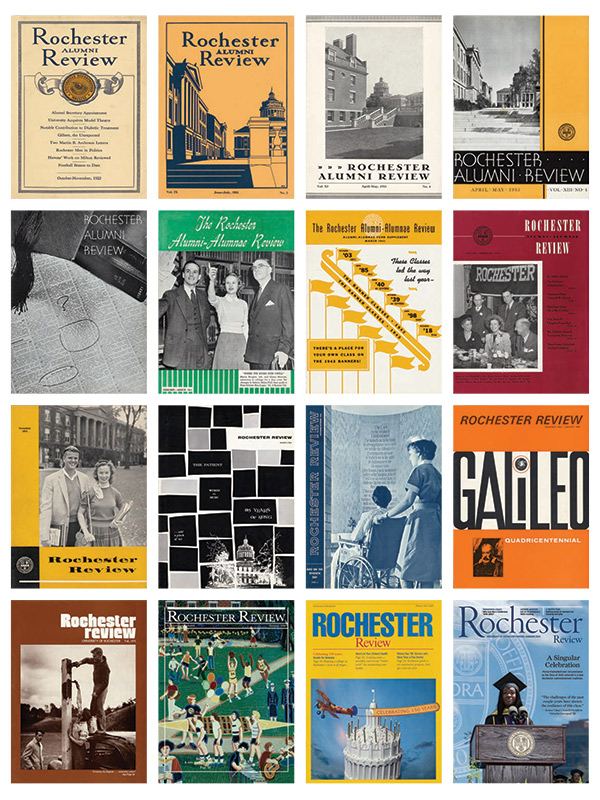Features

CENTURY CLUB: Making its debut in 1922, Rochester Review marks its 100th anniversary with the Fall 2022 issue. Browse the collected history of the magazine.
In the October–November 1922 debut edition of the publication now known as Rochester Review, editor Hugh Smith, Class of 1907, wrote that when fellow alumni learned of his appointment that fall, they would ask, “What are you supposed to do, anyway?”
In a confident but self-deprecating tone that became a hallmark of his “With the Editor” columns, Smith noted that the job of the new publication was to build strong connections among alumni and with their alma mater, to provide the University community with reasons to talk with pride about the institution, and to convey a sense of continuity across generations as the University’s scope and stature grew in the coming years.
To do that, he said, he hoped to establish a “little magazine interesting enough” to be welcomed into the homes of alumni and University friends.
“For if interested in the Review,” Smith wrote, “you are bound to be interested in what lies back of it—and back of it lies your university of the past, the present and the future, memories of your own days on the campus, pride in the present and hope for the days to come.”
As we begin the second century of this “little magazine” this fall, we hope that’s still the case.
Ever Evolving
From its very beginnings, the magazine mirrored the ever-evolving University, chronicling several institutional milestones: the founding of the Medical Center and the Eastman School of Music and the establishment of the River Campus—and the historic fundraising campaign that made the new campus possible. In 1950, the magazine marked the University’s 100th anniversary with a 96-page special issue.
Debuting in 1922 as the Rochester Alumni Review, the magazine was originally based on subscriptions drawn from about 2,400 alumni. The early magazine featured updates on campus activities and sports teams, accounts of reunions, class notes, and reports from alumni across the United States and beyond.
As the institution evolved from a small college to a multi-unit university, Review also adapted, an evolution mirrored in the publication’s changing name. A publication “of-by-and for the alumni of the University of Rochester,” the magazine incorporated “Alumni-Alumnae” into its name in 1939. By 1954, the publication would become Rochester Review.
New Identity
Universities across the country took on new cultural identities in the post–World War II era of the United States, and Review tried to help alumni readers put the era in context.
The magazine of the late-1950s and the 1960s gave space to prominent faculty and campus academic leaders to share their expertise on the changing times and the changing expectations for Rochester and other institutions of higher education. From essays on topics such as “The Challenge of Excellence” and “The University as Myth” to reports from roundtable discussions, Rochester experts analyzed the role of education in American culture, the effectiveness of student protests, the causes of civil and political unrest, and other cultural issues.
With the Fall 1967 issue of Review, the University introduced a new publication as a companion of sorts to the magazine. Appearing six times a year, the new Alumni News featured class notes and other alumni-oriented stories and updates. The quarterly Review continued to focus on the life of the institution, bringing the University to alumni homes but without class notes.
A Fresh Look
Updates to the design and the content during the last decades of the 20th century helped set the template for the current magazine, coalescing around a mix of news about the institution and its place in higher education, features about alumni and the work of faculty, nods to nostalgia and a sense of place, and the return of class notes.
As longtime editor Margaret Bond ’47 wrote in the Winter 1987–88 issue of a design that would last into the 2000s: “Stability is a fine thing, but a little shaking up once in a while is a great freshener.”
In the mid-1970s, when the magazine re-incorporated most of the material of the Alumni News, then editor Ronald Roberts noted that the goal of the move was to combine the best of both publications: material that helped connect alumni with the institution as well as the “lengthier stories which have made the Rochester Review such a special publication.”
“It’s all designed to put the best product in the hands of the most people—and to involve more alumni with their alma mater.”
Key Sources
As Review approached its 100th anniversary, the magazine remained the only University news publication mailed free of charge to all alumni. And while the printed magazine has been regularly “freshened” with new presentations and new departments, the publication also looked for ways to adapt to an increasingly digital world.
The magazine launched a website in 1998 where the content of each issue is posted, and from 2011 to 2016, the publication was available as an electronic app for tablets and mobile phones.
Today, new issues have a corresponding PDF version that can be downloaded from the website, and the magazine’s stories are regularly shared through the University’s main social media and electronic newsletter channels.
Entering its second century, the publication has grown to a circulation of about 150,000 people around the world, including alumni, parents of undergraduates, faculty, staff, donors, and University friends. Recent reader surveys indicate that Review continues to be a key source of information for alumni, just as its founding editors had hoped.

